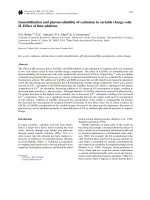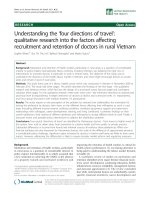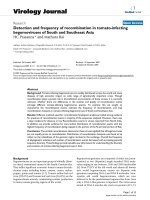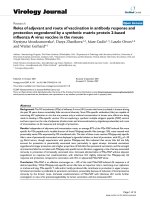Adsorption and aggregation of surfactants in solution
Bạn đang xem bản rút gọn của tài liệu. Xem và tải ngay bản đầy đủ của tài liệu tại đây (6.37 MB, 720 trang )
Marcel Dekker, Inc. New York
•
Basel
ADSORPTION AND
AGGREGATION OF
SURFACTANTS IN
SOLUTION
edited by
K. L. Mittal
Hopewell Junction, New York, U.S.A.
Dinesh O. Shah
University of Florida
Gainesville, Florida, U.S.A.
Copyright © 2002 by Marcel Dekker, Inc. All Rights Reserved.
ISBN: 0-8247-0843-1
This book is printed on acid-free paper.
Headquarters
Marcel Dekker, Inc.
270 Madison Avenue, New York, NY 10016
tel: 212-696-9000; fax: 212-685-4540
Eastern Hemisphere Distribution
Marcel Dekker AG
Hutgasse 4, Postfach 812, CH-4001 Basel, Switzerland
tel: 41-61-260-6300; fax: 41-61-260-6333
World Wide Web
The publisher offers discounts on this book when ordered in bulk quantities. For
more information, write to Special Sales/Professional Marketing at the headquarters
address above.
Copyright ᭧ 2003 by Marcel Dekker, Inc. All Rights Reserved.
Neither this book nor any part may be reproduced or transmitted in any form or by
any means, electronic or mechanical, including photocopying, microfilming, and
recording, or by any information storage and retrieval system, without permission
in writing from the publisher.
Current printing (last digit):
10987654321
PRINTED IN THE UNITED STATES OF AMERICA
SURFACTANT SCIENCE SERIES
FOUNDING EDITOR
MARTIN J. SCHICK
1918–1998
SERIES EDITOR
ARTHUR T. HUBBARD
Santa Barbara Science Project
Santa Barbara, California
ADVISORY BOARD
DANIEL BLANKSCHTEIN
Department of Chemical Engineering
Massachusetts Institute of Technology
Cambridge, Massachusetts
S. KARABORNI
Shell International Petroleum
Company Limited
London, England
LISA B. QUENCER
The Dow Chemical Company
Midland, Michigan
JOHN F. SCAMEHORN
Institute for Applied Surfactant Research
University of Oklahoma
Norman, Oklahoma
P. SOMASUNDARAN
Henry Krumb School of Mines
Columbia University
New York, New York
ERIC W. KALER
Department of Chemical Engineering
University of Delaware
Newark, Delaware
CLARENCE MILLER
Department of Chemical Engineering
Rice University
Houston, Texas
DON RUBINGH
The Procter & Gamble Company
Cincinnati, Ohio
BEREND SMIT
Shell International Oil Products B.V.
Amsterdam, The Netherlands
JOHN TEXTER
Strider Research Corporation
Rochester, New York
1. Nonionic Surfactants, edited by Martin J. Schick (see also Volumes 19, 23, and 60)
2. Solvent Properties of Surfactant Solutions, edited by Kozo Shinoda (see Volume 55)
3. Surfactant Biodegradation, R. D. Swisher (see Volume 18)
4. Cationic Surfactants, edited by Eric Jungermann (see also Volumes 34, 37, and 53)
5. Detergency: Theory and Test Methods (in three parts), edited by W. G. Cutler and R.
C. Davis (see also Volume 20)
6. Emulsions and Emulsion Technology (in three parts), edited by Kenneth J. Lissant
7. Anionic Surfactants (in two parts), edited by Warner M. Linfield (see Volume 56)
8. Anionic Surfactants: Chemical Analysis, edited by John Cross
9. Stabilization of Colloidal Dispersions by Polymer Adsorption, Tatsuo Sato and
Richard Ruch
10. Anionic Surfactants: Biochemistry, Toxicology, Dermatology, edited by Christian
Gloxhuber (see Volume 43)
11. Anionic Surfactants: Physical Chemistry of Surfactant Action, edited by E. H.
Lucassen-Reynders
12. Amphoteric Surfactants, edited by B. R. Bluestein and Clifford L. Hilton (see Volume
59)
13. Demulsification: Industrial Applications, Kenneth J. Lissant
14. Surfactants in Textile Processing, Arved Datyner
15. Electrical Phenomena at Interfaces: Fundamentals, Measurements, and Applications,
edited by Ayao Kitahara and Akira Watanabe
16. Surfactants in Cosmetics, edited by Martin M. Rieger (see Volume 68)
17. Interfacial Phenomena: Equilibrium and Dynamic Effects, Clarence A. Miller and P.
Neogi
18. Surfactant Biodegradation: Second Edition, Revised and Expanded, R. D. Swisher
19. Nonionic Surfactants: Chemical Analysis, edited by John Cross
20. Detergency: Theory and Technology, edited by W. Gale Cutler and Erik Kissa
21. Interfacial Phenomena in Apolar Media, edited by Hans-Friedrich Eicke and Geoffrey
D. Parfitt
22. Surfactant Solutions: New Methods of Investigation, edited by Raoul Zana
23. Nonionic Surfactants: Physical Chemistry, edited by Martin J. Schick
24. Microemulsion Systems, edited by Henri L. Rosano and Marc Clausse
25. Biosurfactants and Biotechnology, edited by Naim Kosaric, W. L. Cairns, and Neil C.
C. Gray
26. Surfactants in Emerging Technologies, edited by Milton J. Rosen
27. Reagents in Mineral Technology, edited by P. Somasundaran and Brij M. Moudgil
28. Surfactants in Chemical/Process Engineering, edited by Darsh T. Wasan, Martin E.
Ginn, and Dinesh O. Shah
29. Thin Liquid Films, edited by I. B. Ivanov
30. Microemulsions and Related Systems: Formulation, Solvency, and Physical
Properties, edited by Maurice Bourrel and Robert S. Schechter
31. Crystallization and Polymorphism of Fats and Fatty Acids, edited by Nissim Garti and
Kiyotaka Sato
32. Interfacial Phenomena in Coal Technology, edited by Gregory D. Botsaris and Yuli M.
Glazman
33. Surfactant-Based Separation Processes, edited by John F. Scamehorn and Jeffrey H.
Harwell
34. Cationic Surfactants: Organic Chemistry, edited by James M. Richmond
35. Alkylene Oxides and Their Polymers, F. E. Bailey, Jr., and Joseph V. Koleske
36. Interfacial Phenomena in Petroleum Recovery, edited by Norman R. Morrow
37. Cationic Surfactants: Physical Chemistry, edited by Donn N. Rubingh and Paul M.
Holland
38. Kinetics and Catalysis in Microheterogeneous Systems, edited by M. Grätzel and K.
Kalyanasundaram
39. Interfacial Phenomena in Biological Systems, edited by Max Bender
40. Analysis of Surfactants, Thomas M. Schmitt (see Volume 96)
41. Light Scattering by Liquid Surfaces and Complementary Techniques, edited by
Dominique Langevin
42. Polymeric Surfactants, Irja Piirma
43. Anionic Surfactants: Biochemistry, Toxicology, Dermatology. Second Edition, Revised
and Expanded, edited by Christian Gloxhuber and Klaus Künstler
44. Organized Solutions: Surfactants in Science and Technology, edited by Stig E.
Friberg and Björn Lindman
45. Defoaming: Theory and Industrial Applications, edited by P. R. Garrett
46. Mixed Surfactant Systems, edited by Keizo Ogino and Masahiko Abe
47. Coagulation and Flocculation: Theory and Applications, edited by Bohuslav Dobiáð
48. Biosurfactants: Production · Properties · Applications, edited by Naim Kosaric
49. Wettability, edited by John C. Berg
50. Fluorinated Surfactants: Synthesis · Properties · Applications, Erik Kissa
51. Surface and Colloid Chemistry in Advanced Ceramics Processing, edited by Robert
J. Pugh and Lennart Bergström
52. Technological Applications of Dispersions, edited by Robert B. McKay
53. Cationic Surfactants: Analytical and Biological Evaluation, edited by John Cross and
Edward J. Singer
54. Surfactants in Agrochemicals, Tharwat F. Tadros
55. Solubilization in Surfactant Aggregates, edited by Sherril D. Christian and John F.
Scamehorn
56. Anionic Surfactants: Organic Chemistry, edited by Helmut W. Stache
57. Foams: Theory, Measurements, and Applications, edited by Robert K. Prud'homme
and Saad A. Khan
58. The Preparation of Dispersions in Liquids, H. N. Stein
59. Amphoteric Surfactants: Second Edition, edited by Eric G. Lomax
60. Nonionic Surfactants: Polyoxyalkylene Block Copolymers, edited by Vaughn M. Nace
61. Emulsions and Emulsion Stability, edited by Johan Sjöblom
62. Vesicles, edited by Morton Rosoff
63. Applied Surface Thermodynamics, edited by A. W. Neumann and Jan K. Spelt
64. Surfactants in Solution, edited by Arun K. Chattopadhyay and K. L. Mittal
65. Detergents in the Environment, edited by Milan Johann Schwuger
66. Industrial Applications of Microemulsions, edited by Conxita Solans and Hironobu
Kunieda
67. Liquid Detergents, edited by Kuo-Yann Lai
68. Surfactants in Cosmetics: Second Edition, Revised and Expanded, edited by Martin M.
Rieger and Linda D. Rhein
69. Enzymes in Detergency, edited by Jan H. van Ee, Onno Misset, and Erik J. Baas
70. Structure-Performance Relationships in Surfactants, edited by Kunio Esumi and
Minoru Ueno
71. Powdered Detergents, edited by Michael S. Showell
72. Nonionic Surfactants: Organic Chemistry, edited by Nico M. van Os
73. Anionic Surfactants: Analytical Chemistry, Second Edition, Revised and Expanded,
edited by John Cross
74. Novel Surfactants: Preparation, Applications, and Biodegradability, edited by Krister
Holmberg
75. Biopolymers at Interfaces, edited by Martin Malmsten
76. Electrical Phenomena at Interfaces: Fundamentals, Measurements, and Applications,
Second Edition, Revised and Expanded, edited by Hiroyuki Ohshima and Kunio
Furusawa
77. Polymer-Surfactant Systems, edited by Jan C. T. Kwak
78. Surfaces of Nanoparticles and Porous Materials, edited by James A. Schwarz and
Cristian I. Contescu
79. Surface Chemistry and Electrochemistry of Membranes, edited by Torben Smith
Sørensen
80. Interfacial Phenomena in Chromatography, edited by Emile Pefferkorn
81. Solid–Liquid Dispersions, Bohuslav Dobiáð, Xueping Qiu, and Wolfgang von Rybinski
82. Handbook of Detergents, editor in chief: Uri Zoller
Part A: Properties, edited by Guy Broze
83. Modern Characterization Methods of Surfactant Systems, edited by Bernard P. Binks
84. Dispersions: Characterization, Testing, and Measurement, Erik Kissa
85. Interfacial Forces and Fields: Theory and Applications, edited by Jyh-Ping Hsu
86. Silicone Surfactants, edited by Randal M. Hill
87. Surface Characterization Methods: Principles, Techniques, and Applications, edited
by Andrew J. Milling
88. Interfacial Dynamics, edited by Nikola Kallay
89. Computational Methods in Surface and Colloid Science, edited by Ma
ù
gorzata
Borówko
90. Adsorption on Silica Surfaces, edited by Eugène Papirer
91. Nonionic Surfactants: Alkyl Polyglucosides, edited by Dieter Balzer and Harald
Lüders
92. Fine Particles: Synthesis, Characterization, and Mechanisms of Growth, edited by
Tadao Sugimoto
93. Thermal Behavior of Dispersed Systems, edited by Nissim Garti
94. Surface Characteristics of Fibers and Textiles, edited by Christopher M. Pastore and
Paul Kiekens
95. Liquid Interfaces in Chemical, Biological, and Pharmaceutical Applications, edited by
Alexander G. Volkov
96. Analysis of Surfactants: Second Edition, Revised and Expanded, Thomas M. Schmitt
97. Fluorinated Surfactants and Repellents: Second Edition, Revised and Expanded,
Erik Kissa
98. Detergency of Specialty Surfactants, edited by Floyd E. Friedli
99. Physical Chemistry of Polyelectrolytes, edited by Tsetska Radeva
100. Reactions and Synthesis in Surfactant Systems, edited by John Texter
101. Protein-Based Surfactants: Synthesis, Physicochemical Properties, and Applications,
edited by Ifendu A. Nnanna and Jiding Xia
102. Chemical Properties of Material Surfaces, Marek Kosmulski
103. Oxide Surfaces, edited by James A. Wingrave
104. Polymers in Particulate Systems: Properties and Applications, edited by Vincent A.
Hackley, P. Somasundaran, and Jennifer A. Lewis
105. Colloid and Surface Properties of Clays and Related Minerals, Rossman F. Giese
and Carel J. van Oss
106. Interfacial Electrokinetics and Electrophoresis, edited by Ángel V. Delgado
107. Adsorption: Theory, Modeling, and Analysis, edited by József Tóth
108. Interfacial Applications in Environmental Engineering, edited by Mark A. Keane
109. Adsorption and Aggregation of Surfactants in Solution, edited by K. L. Mittal and
Dinesh O. Shah
110. Biopolymers at Interfaces: Second Edition, Revised and Expanded, edited by Martin
Malmsten
111. Biomolecular Films: Design, Function, and Applications, edited by James F. Rusling
112. Structure–Performance Relationships in Surfactants: Second Edition, Revised and
Expanded, edited by Kunio Esumi and Minoru Ueno
ADDITIONAL VOLUMES IN PREPARATION
Liquid Interfacial Systems: Oscillations and Instability, Rudolph V. Birikh, Vladimir A.
Briskman, Manuel G. Velarde, and Jean-Claude Legros
Novel Surfactants: Preparation, Applications, and Biodegradability: Second Edition,
Revised and Expanded, edited by Krister Holmberg
Colloidal Polymers: Preparation and Biomedical Applications, edited by Abdelhamid
Elaissari
iii
Preface
This volume embodies, in part, the proceedings of the 13th International
Symposium on Surfactants in Solution (SIS) held in Gainesville, Florida,
June 11–16, 2000. The theme of this particular SIS was ‘‘Surfactant Science
and Technology for the New Millennium.’’ The final technical program com-
prised 360 papers, including 96 poster presentations, which was a testimonial
to the brisk research activity in the arena of surfactants in solution. In light
of the legion of papers, to chronicle the total account of this event would
have been impractical, so we decided to document only the plenary and
invited presentations. The contributors were asked to cover their topics in a
general manner; concomitantly, this book reflects many excellent reviews of
a number of important ramifications of surfactants in solution.
Chapters 1–4 document the plenary lectures, including the written ac-
count of the special ‘‘Host Lecture’’ by one of us (DOS) and Prof. Brij
Moudgil. Chapters 5–32 embody the text of 28 invited presentations cov-
ering many aspects of surfactants in solution. Among the topics covered are:
surfactant-stabilized particles; solid particles at liquid interfaces; nanocap-
sules; aggregation behavior of surfactants; micellar catalysis; vesicles and
liposomes; the clouding phenomenon; viscoelasticity of micellar solutions;
phase behavior of microemulsions; reactions in microemulsions; viscosity
index improvers; foams, foam films, and monolayers; principles of emulsion
formulation engineering; nano-emulsions; liposome gene delivery; poly-
meric surfactants; and combinatorial surface chemistry.
As surfactants play an important role in many and diverse technologies,
ranging from high-tech (microelectronics) to low-tech (washing clothes) ap-
plications, an understanding of their behavior in solution is of paramount
iv Preface
importance. Also, as we learn more about surfactants and devise new sur-
factant formulations, novel and exciting applications will emerge.
The present compendium of excellent overviews and research papers pro-
vides a bounty of up-to-date information on the many and varied aspects of
surfactants in solution. It also offers a commentary on current research ac-
tivity regarding the behavior of surfactants in solution. We hope that anyone
involved or interested—centrally or tangentially—in surfactants will find
this book useful. Further, we trust that both veteran researchers and those
embarking on their maiden voyage in the wonderful world of surfactants
will find this treatise valuable.
To put together a symposium of this magnitude and quality requires ded-
ication and unflinching help from a battalion of people, and now it is our
pleasure and duty to acknowledge those who helped in many and varied
manners in this endeavor. First and foremost, we express our heartfelt and
most sincere thanks to Prof. Brij Moudgil, Director of the Engineering Re-
search Center for Particle Science and Technology, University of Florida,
for helping in more ways than one. He wore many different hats—as co-
chairman, as troubleshooter, as local host—and he was always ready and
willing to help with a smile. Next we are thankful to faculty members,
postdoctoral associates, graduate students, and administrative staff of both
the Center for Surface Science and Engineering and the Engineering Re-
search Center for Particle Science and Technology, University of Florida.
We acknowledge the generous support of the following organizations: the
Florida Institute of Phosphate Research, the National Science Foundation,
and the University of Florida. Many individual industrial corporations helped
us by providing generous financial support and we are grateful to them. We
also thank the exhibitors of scientific instruments and books for their con-
tribution and support.
We are grateful to the authors for their interest, enthusiasm, and contri-
bution without which this book would not have seen the light of day. Last,
we are appreciative of the efforts of the staff at Marcel Dekker, Inc. for
giving this book a body form.
K. L. Mittal
Dinesh O. Shah
v
Contents
Preface iii
Contributors ix
1. Highlights of Research on Molecular Interactions at Interfaces from
the University of Florida 1
Dinesh O. Shah and Brij M. Moudgil
2. Interaction Between Surfactant-Stabilized Particles:
Dynamic Aspects 49
J. Lyklema
3. Solid Particles at Liquid Interfaces, Including Their Effects on
Emulsion and Foam Stability 61
Robert Aveyard and John H. Clint
4. From Polymeric Films to Nanocapsules 91
Helmuth Mo¨hwald, Heinz Lichtenfeld, Sergio Moya, A. Voight,
G. B. Sukhorukov, Stefano Leporatti, L. Da¨hne, Igor Radtchenko,
Alexei A. Antipov, Changyou Gao, and Edwin Donath
5. Investigation of Amphiphilic Systems by Subzero Temperature
Differential Scanning Calorimetry 105
Shmaryahu Ezrahi, Abraham Aserin, and Nissim Garti
6. Aggregation Behavior of Dimeric and Gemini Surfactants in
Solution: Raman, Selective Decoupling
13
C NMR, and
SANS Studies 133
Hirofumi Okabayashi, Norikatsu Hattori, and Charmian J. O’Connor
vi Contents
7. Snared by Trapping: Chemical Explorations of Interfacial
Compositions of Cationic Micelles 149
Laurence S. Romsted
8. Effect of Surfactants on Pregastric Enzyme–Catalyzed Hydrolysis of
Triacylglycerols and Esters 171
Charmian J. O’Connor, Douglas T. Lai, and Cynthia Q. Sun
9. Effect of Benzyl Alcohol on the Properties of CTAB/KBr
Micellar Systems 189
Ganzuo Li, Weican Zhang, Li-Qiang Zheng, and Qiang Shen
10. Vesicle Formation by Chemical Reactions: Spontaneous Vesicle
Formation in Mixtures of Zwitterionic and Catanionic
Surfactants 201
Klaus Horbaschek, Michael Gradzielski, and Heinz Hoffmann
11. Mechanism of the Clouding Phenomenon in Surfactant
Solutions 211
C. Manohar
12. Atomic Force Microscopy of Adsorbed Surfactant Micelles 219
William A. Ducker
13. A Simple Model to Predict Nonlinear Viscoelasticity and Shear
Banding Flow of Wormlike Micellar Solutions 243
J. E. Puig, F. Bautista, J. H. Pe´rez-Lo´pez, J. F. A. Soltero, and
Octavio Manero
14. Preparation and Stabilization of Silver Colloids in Aqueous
Surfactant Solutions 255
Dae-Wook Kim, Seung-Il Shin, and Seong-Geun Oh
15. Silver and Palladium Nanoparticles Incorporated in Layer
Structured Materials 269
Rita Patakfalvi, Szilvia Papp, and Imre De´ka´ny
16. Water-in-Carbon Dioxide Microemulsions Stabilized by
Fluorosurfactants 299
Julian Eastoe, Alison Paul, David Steytler, Emily Rumsey,
Richard K. Heenan, and Jeffrey Penfold
17. Organic Synthesis in Microemulsions: An Alternative or a
Complement to Phase Transfer Catalysis 327
Krister Holmberg and Maria Ha¨ger
Contents vii
18. Physicochemical Characterization of Nanoparticles Synthesized
in Microemulsions 343
J. B.Nagy, L. Jeunieau, F. Debuigne, and I. Ravet-Bodart
19. Phase Behavior of Microemulsion Systems Based on Optimized
Nonionic Surfactants 387
Wolfgang von Rybinski and Matthias Wegener
20. Microemulsions in Foods: Challenges and Applications 407
Anilkumar G. Gaonkar and Rahul Prabhakar Bagwe
21. Microemulsion-Based Viscosity Index Improvers 431
Surekha Devi and Naveen Kumar Pokhriyal
22. Foams, Foam Films, and Monolayers 453
Dominique Langevin
23. Role of Entry Barriers in Foam Destruction by Oil Drops 465
Asen D. Hadjiiski, Nikolai D. Denkov, Slavka S. Tcholakova, and
Ivan B. Ivanov
24. Principles of Emulsion Formulation Engineering 501
Jean-Louis Salager, Laura Ma´rquez, Isabel Mira, Alejandro
˜
Pena,
Eric Tyrode, and Noelia B. Zambrano
25. Nano-Emulsions: Formation, Properties, and Applications 525
Conxita Solans, Jordi Esquena, Ana Maria Forgiarini, Nu´ria Uso´n,
Daniel Morales, Paqui Izquierdo, Nu´ria Azemar, and
Marı´a Jose´ Garcı´a-Celma
26. Surface Modifications of Liposomes for Recognition and Response
to Environmental Stimuli 555
Jong-Duk Kim, Soo Kyoung Bae, Jin-Chul Kim, and Eun-Ok Lee
27. Specific Partition of Surface-Modified Liposomes in Aqueous
PEO/Polysaccharide Two-Phase Systems 579
Eui-Chul Kang, Kazunari Akiyoshi, and Junzo Sunamoto
28. Novel Cationic Transfection Lipids for Use in Liposomal
Gene Delivery 603
Rajkumar Banerjee, Prasanta Kumar Das,
Gollapudi Venkata Srilakshmi, Nalam Madhusudhana Rao, and
Arabinda Chaudhuri
29. Combinatorial Surface Chemistry: A Novel Concept for Langmuir
and Langmuir–Blodgett Films Research 619
Qun Huo and Roger M. Leblanc
viii Contents
30. Oscillating Structural Forces Reflecting the Organization of Bulk
Solutions and Surface Complexes 635
Per M. Claesson and Vance Bergeron
31. Effect of Polymeric Surfactants on the Behavior of Polycrystalline
Materials with Special Reference to Ammonium Nitrate 655
Arun Kumar Chattopadhyay
32. Surface Tension Measurements with Top-Loading Balances 675
Brian Grady, Andrew R. Slagle, Linda Zhu, Edward E. Tucker,
Sherril D. Christian, and John F. Scamehorn
Index 689
ix
Contributors
Kazunari Akiyoshi Department of Synthetic Chemistry and Biological
Chemistry, Kyoto University, Kyoto, Japan
Alexei A. Antipov Max-Planck-Institute of Colloids and Interfaces, Pots-
dam, Germany
Abraham Aserin Casali Institute of Applied Chemistry, The Hebrew
University of Jerusalem, Jerusalem, Israel
Robert Aveyard Department of Chemistry, Hull University, Hull, United
Kingdom
Nu´ ria Azemar Departament de Tecnologia de Tensioactius, Institut
d’Investigacions Quı´miques i Ambientals de Barcelona, Barcelona, Spain
Soo Kyoung Bae Department of Chemical and Biomolecular Engineer-
ing, KAIST, Daejeon, Korea
Rahul Prabhakar Bagwe Department of Chemical Engineering, Uni-
versity of Florida, Gainesville, Florida, U.S.A.
Rajkumar Banerjee* Division of Lipid Science and Technology, Indian
Institute of Chemical Technology, Hyderabad, India
*Current affiliation: University of Pittsburgh, Pittsburgh, Pennsylvania, U.S.A.
x Contributors
F. Bautista Departamento de Ingenierı´a Quı´mica, Universidad de Gua-
dalajara, Guadalajara, Mexico
Vance Bergeron Ecole Normale Superieure, Paris, France
Arun Kumar Chattopadhyay Corporate Research and Development,
United States Bronze Powders Group of Companies, Haskell, New Jersey,
U.S.A.
Arabinda Chaudhuri Division of Lipid Science and Technology, Indian
Institute of Chemical Technology, Hyderabad, India
Sherril D. Christian
†
Institute for Applied Surfactant Research, Univer-
sity of Oklahoma, Norman, Oklahoma, U.S.A.
Per M. Claesson Department of Chemistry, Surface Chemistry, Royal In-
stitute of Technology, and Institute for Surface Chemistry, Stockholm, Swe-
den
John H. Clint Department of Chemistry, Hull University, Hull, United
Kingdom
L. Da¨ hne Max-Planck-Institute of Colloids and Interfaces, Potsdam, Ger-
many
Prasanta Kumar Das* Division of Lipid Science and Technology, Indian
Institute of Chemical Technology, Hyderabad, India
F. Debuigne Laboratoire de Re´sonance Magne´tique Nucle´aire, Faculte´s
Universitaires Notre-Dame de la Paix, Namur, Belgium
Imre De´ka´ny Department of Colloid Chemistry, University of Szeged,
Szeged, Hungary
Nikolai D. Denkov Laboratory of Chemical Physics and Engineering,
Faculty of Chemistry, Sofia University, Sofia, Bulgaria
Surekha Devi Department of Chemistry, M. S. University of Baroda,
Baroda, Gujarat, India
†
Deceased.
*Current affiliation: Massachusetts Institute of Technology, Cambridge, Massachusetts, U.S.A.
Contributors xi
Edwin Donath Department of Biophysics, Institute of Medical Physics
and Biophysics, University of Leipzig, Leipzig, Germany
William A. Ducker Department of Chemistry, Virginia Tech, Blacksburg,
Virginia, U.S.A.
Julian Eastoe School of Chemistry, University of Bristol, Bristol, United
Kingdom
Jordi Esquena Departament de Tecnologia de Tensioactius, Institut
d’Investigacions Quı´miques i Ambientals de Barcelona, Barcelona, Spain
Shmaryahu Ezrahi Technology and Development Division, IDF, Tel
Hashomer, Israel
Ana Maria Forgiarini Departament de Tecnologia de Tensioactius, Insti-
tut d’Investigacions Quı´miques i Ambientals de Barcelona, Barcelona, Spain
Changyou Gao Department of Polymer Science and Engineering, Zhe-
jiang University, Hangzhou, People’s Republic of China
Anilkumar G. Gaonkar Research and Development, Kraft Foods, Inc.,
Glenview, Illinois, U.S.A.
Marı´a Jose´ Garcı´a-Celma Departament de Farma`cia, Facultad de Far-
ma`cia, Universitat de Barcelona, Barcelona, Spain
Nissim Garti Casali Institute of Applied Chemistry, The Hebrew Univer-
sity of Jerusalem, Jerusalem, Israel
Brian Grady School of Chemical Engineering and Materials Science,
University of Oklahoma, Norman, Oklahoma, U.S.A.
Michael Gradzielski Physical Chemistry I, University of Bayreuth, Bay-
reuth, Germany
Asen D. Hadjiiski Laboratory of Chemical Physics and Engineering, Fac-
ulty of Chemistry, Sofia University, Sofia, Bulgaria
Maria Ha¨ger Institute for Surface Chemistry, Stockholm, Sweden
xii Contributors
Norikatsu Hattori* Department of Applied Chemistry, Nagoya Institute
of Technology, Nagoya, Japan
Richard K. Heenan ISIS Facility, Rutherford Appleton Laboratory, Chil-
ton, United Kingdom
Heinz Hoffmann Physical Chemistry I, University of Bayreuth, Bay-
reuth, Germany
Krister Holmberg Department of Applied Surface Chemistry, Chalmers
University of Technology, Go¨teborg, Sweden
Klaus Horbaschek Physical Chemistry I, University of Bayreuth, Bay-
reuth, Germany
Qun Huo Department of Polymers and Coatings, North Dakota State Uni-
versity, Fargo, North Dakota, U.S.A.
Ivan B. Ivanov Laboratory of Chemical Physics and Engineering, Faculty
of Chemistry, Sofia University, Sofia, Bulgaria
Paqui Izquierdo Departament de Tecnologia de Tensioactius, Institut
d’Investigacions Quı´miques i Ambientals de Barcelona, Barcelona, Spain
L. Jeunieau Laboratoire de Re´sonance Magne´tique Nucle´aire, Faculte´s
Universitaires Notre-Dame de la Paix, Namur, Belgium
Eui-Chul Kang Department of Synthetic Chemistry and Biological
Chemistry, Kyoto University, Kyoto, Japan
Dae-Wook Kim Department of Chemical Engineering and CUPS, Han-
yang University, Seoul, Korea
Jin-Chul Kim Department of Chemical and Biomolecular Engineering,
KAIST, Daejeon, Korea
Jong-Duk Kim Department of Chemical and Biomolecular Engineering,
KAIST, Daejeon, Korea
Douglas T. Lai Development Center for Biotechnology, Taipei, Taiwan
*Current affiliation: Chisso Corporation, Tokyo, Japan.
Contributors xiii
Dominique Langevin Laboratoire de Physique des Solides, Universite´
Paris Sud, Orsay, France
Roger M. Leblanc Department of Chemistry, University of Miami, Coral
Gables, Florida, U.S.A.
Eun-Ok Lee Department of Chemical and Biomolecular Engineering,
KAIST, Daejeon, Korea
Stefano Leporatti Institute of Medical Physics and Biophysics, Univer-
sity of Leipzig, Leipzig, Germany
Ganzuo Li Key Laboratory for Colloid and Interface Chemistry of State
Education Ministry, Shandong University, Jinan, People’s Republic of China
Heinz Lichtenfeld Max-Planck-Institute of Colloids and Interfaces, Pots-
dam, Germany
J. Lyklema Physical Chemistry and Colloid Science, Wageningen Uni-
versity, Wageningen, The Netherlands
Octavio Manero Instituto de Investigaciones en Materiales, Universidad
Nacional Auto´noma de Me´xico, Mexico City, Mexico
C. Manohar Department of Chemical Engineering, Indian Institute of
Technology, Mumbai, India
Laura Ma´rquez Laboratory FIRP, School of Chemical Engineering, Uni-
versity of the Andes, Me´rida, Venezuela
Isabel Mira* Laboratory FIRP, School of Chemical Engineering, Univer-
sity of the Andes, Me´rida, Venezuela
Helmuth Mo¨hwald Max-Planck-Institute of Colloids and Interfaces,
Potsdam, Germany
Daniel Morales Departament de Tecnologia de Tensioactius, Institut
d’Investigacions Quı´miques i Ambientals de Barcelona, Barcelona, Spain
*Current affiliation: Institute for Surface Chemistry, Stockholm, Sweden.
xiv Contributors
Brij M. Moudgil Engineering Research Center, University of Florida,
Gainesville, Florida, U.S.A.
Sergio Moya Max-Planck-Institute of Colloids and Interfaces, Potsdam,
Germany
J. B.Nagy Laboratoire de Re´sonance Magne´tique Nucle´aire, Faculte´s
Universitaires Notre-Dame de la Paix, Namur, Belgium
Charmian J. O’Connor Department of Chemistry, The University of
Auckland, Auckland, New Zealand
Seong-Geun Oh Department of Chemical Engineering and CUPS, Han-
yang University, Seoul, Korea
Hirofumi Okabayashi Department of Applied Chemistry, Nagoya Insti-
tute of Technology, Nagoya, Japan
Szilvia Papp Department of Colloid Chemistry and Nanostructured Ma-
terials Research Group, Hungarian Academy of Sciences, University of Sze-
ged, Szeged, Hungary
Rita Patakfalvi Department of Colloid Chemistry and Nanostructured
Materials Research Group, Hungarian Academy of Sciences, University of
Szeged, Szeged, Hungary
Alison Paul School of Chemistry, University of Bristol, Bristol, United
Kingdom
Alejandro * Laboratory FIRP, School of Chemical Engineering,
˜
Pena
University of the Andes, Me´rida, Venezuela
Jeffrey Penfold ISIS Facility, Rutherford Appleton Laboratory, Chilton,
United Kingdom
J. H. Pe´ rez-Lo´pez Departamento de Ingenierı´a Quı´mica, Universidad de
Guadalajara, Guadalajara, Mexico
Naveen Kumar Pokhriyal Department of Chemistry, M. S. University
of Baroda, Baroda, Gujarat, India
*Current affiliation: Rice University, Houston, Texas, U.S.A.
Contributors xv
J. E. Puig Departamento de Ingenierı´a Quı´mica, Universidad de Gua-
dalajara, Guadalajara, Mexico
Igor Radtchenko Max-Planck-Institute of Colloids and Interfaces, Pots-
dam, Germany
Nalam Madhusudhana Rao Centre for Cellular and Molecular Biology,
Hyderabad, India
I. Ravet-Bodart Laboratoire de Re´sonance Magne´tique Nucle´aire, Facul-
te´s Universitaires Notre-Dame de la Paix, Namur, Belgium
Laurence S. Romsted Department of Chemistry and Chemical Biology,
Rutgers, The State University of New Jersey, New Brunswick, New Jersey,
U.S.A.
Emily Rumsey School of Chemical Sciences, University of East Anglia,
Norwich, United Kingdom
Jean-Louis Salager Laboratory FIRP, School of Chemical Engineering,
University of the Andes, Me´rida, Venezuela
John F. Scamehorn Institute for Applied Surfactant Research, Univer-
sity of Oklahoma, Norman, Oklahoma, U.S.A.
Dinesh O. Shah Departments of Chemical Engineering and Anesthesi-
ology, Center for Surface Science and Engineering, University of Florida,
Gainesville, Florida, U.S.A.
Qiang Shen Key Laboratory for Colloid and Interface Chemistry of State
Education Ministry, Shandong University, Jinan, People’s Republic of China
Seung-Il Shin Department of Chemical Engineering and CUPS, Hanyang
University, Seoul, Korea
Andrew R. Slagle Institute for Applied Surfactant Research, University
of Oklahoma, Norman, Oklahoma, U.S.A.
Conxita Solans Departament de Tecnologia de Tensioactius, Institut
d’Investigacions Quı´miques i Ambientals de Barcelona, Barcelona, Spain
J. F. A. Soltero Departamento de Ingenierı´a Quı´mica, Universidad de
Guadalajara, Guadalajara, Mexico
xvi Contributors
Gollapudi Venkata Srilakshmi Division of Lipid Science and Technol-
ogy, Indian Institute of Chemical Technology, Hyderabad, India
David Steytler School of Chemical Sciences, University of East Anglia,
Norwich, United Kingdom
G. B. Sukhorukov Max-Planck-Institute of Colloids and Interfaces, Pots-
dam, Germany
Cynthia Q. Sun* Department of Chemistry, The University of Auckland,
Auckland, New Zealand
Junzo Sunamoto Advanced Research and Technology Center, Niihama
National College of Technology, Ehime, Japan
Slavka S. Tcholakova Laboratory of Chemical Physics and Engineering,
Faculty of Chemistry, Sofia University, Sofia, Bulgaria
Edward E. Tucker Institute for Applied Surfactant Research, University
of Oklahoma, Norman, Oklahoma, U.S.A.
Eric Tyrode
†
Laboratory FIRP, School of Chemical Engineering, Univer-
sity of the Andes, Me´rida, Venezuela
Nu´ ria Uso´n Departament de Tecnologia de Tensioactius, Institut
d’Investigacions Quı´miques i Ambientals de Barcelona, Barcelona, Spain
A. Voight Max-Planck-Institute of Colloids and Interfaces, Potsdam, Ger-
many
Wolfgang von Rybinski Corporate Research, Henkel KGaA, Du¨ssel-
dorf, Germany
Matthias Wegener Corporate Research, Henkel KGaA, Du¨sseldorf, Ger-
many
Noelia B. Zambrano
‡
Laboratory FIRP, School of Chemical Engineer-
ing, University of the Andes, Me´rida, Venezuela
Current affiliation:
*Hort Research, Auckland, New Zealand.
†
Royal Institute of Technology (KTH), Stockholm, Sweden.
‡
M.W. Kellogg Ltd., Middlesex, United Kingdom.
Contributors xvii
Weican Zhang State Key Laboratory of Microbial Technology, Shandong
University, Jinan, People’s Republic of China
Li-Qiang Zheng Department of Chemistry, Shandong University, Jinan,
People’s Republic of China
Linda Zhu Institute for Applied Surfactant Research, University of
Oklahoma, Norman, Oklahoma, U.S.A.
1
1
Highlights of Research on
Molecular Interactions at
Interfaces from the University
of Florida
DINESH O. SHAH and BRIJ M. MOUDGIL
University of
Florida, Gainesville, Florida, U.S.A.
ABSTRACT
An overview of research highlights of the past three decades from the Uni-
versity of Florida on molecular interactions at interfaces and in micelles is
presented. This overview includes work on (1) the kinetic stability of mi-
celles in relation to technological processes, (2) molecular packing in mixed
monolayers and phase transition in monolayers, (3) microemulsions and their
technological applications including enhanced oil recovery (EOR) processes
and preparation of nanoparticles of advanced materials, (4) adsorption of
polymers at solid–liquid interfaces and selective flocculation, and (5) the
mechanical strength of surfactant films at the solid–liquid interface and its
correlation with dispersion stability as well as the interfacial phenomena in
chemical–mechanical polishing (CMP) of silicon wafers. Detailed results
explaining the role of molecular interactions at interfaces and in micelles as
well as pertinent references are given for each phenomenon discussed.
I. INTRODUCTION
It is a great pleasure and privilege for us to summarize the highlights of
research on molecular interactions at interfaces from the University of
Florida on this 13th International Symposium on Surfactants in Solution
(SIS-2000). During the past 30 years at the University of Florida, we have
had an ongoing research program on fundamental aspects as well as tech-
nological applications of interfacial processes. Specifically, this overview
2 Shah and Moudgil
includes the kinetic stability of micelles in relation to technological pro-
cesses, molecular packing in mixed monolayers and phase transition in mon-
olayers, microemulsions and their technological applications including en-
hanced oil recovery (EOR) processes and preparation of nanoparticles of
advanced materials, adsorption of polymers at solid–liquid interface and
selective flocculation, the mechanical strength of surfactant films at the
solid–liquid interface and dispersion stability, and the interfacial phenomena
in chemical mechanical polishing (CMP) of silicon wafers.
II. MONOLAYERS
During the past quarter century, considerable studies have been carried out
on the reactions in monomolecular films of surfactant, or monolayers. Figure
1 shows the surface pressure–area curves for dioleoyl, soybean, egg, and
dipalmitoyl lecithins [1]. For these four lecithins, the fatty acid composition
was determined by gas chromatography. The dioleoyl lecithin has both
chains unsaturated, soybean lecithin has polyunsaturated fatty acid chains,
egg lecithin has 50% saturated and 50% unsaturated chains, and dipalmitoyl
lecithin has both chains fully saturated. It is evident that, at any fixed surface
pressure, the area per molecule is in the following order:
Dioleoyl lecithin > soybean lecithin > egg lecithin > dipalmitoyl lecithin
It can be assumed that the area per molecule represents the area of a square
at the interface. Thus, the square root of the area per molecule gives the
length of one side of the square, which represents the intermolecular dis-
tance. Figure 2 schematically illustrates the area per molecule and inter-
molecular distance in these four lecithins. The corresponding intermolecular
distances were calculated to be 9.5, 8.8, 7.1, and 6.5 A
˚
, respectively, at a
surface pressure of 20 mN/m [2]. Thus, one can conclude that a change in
the saturation of the fatty acid chains produces subangstrom changes in the
intermolecular distance in the monolayer.
In addition, it was desired to explore the effects that these small changes
in intermolecular distance had on the enzymatic susceptibility of these lec-
ithins to hydrolytic enzymes such as phospholipase A [3–5], a potent hy-
drolytic enzyme found in cobra venom. Thus, microgram quantities of en-
zyme were injected under this monolayer. By measuring the rate of change
of surface potential, one can indirectly measure the rate of reaction in the
monolayer. It is assumed that these quantities [i.e., change in surface poten-
tial ⌬(⌬V ) and the extent of reaction] are proportional to each other. The
kinetics of hydrolysis, as measured by a decrease in surface potential, were
studied for each lecithin monolayer as a function of initial surface pressure
and are shown in Fig. 3 [6]. It was found that initially the reaction rate









